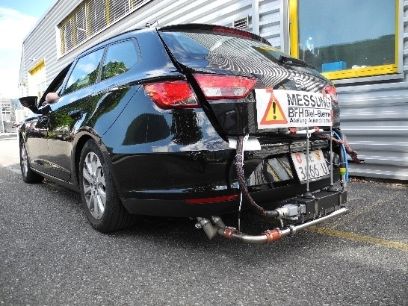- Forschungsprojekt
Research on PEMS testing methodology and on real driving emissions (RDE)
Measuring and controlling of real driving emissions (RDE) of passenger cars with PEMS (portable emission measuring systems) is an actual requirement for legal testing. In the project «Research RDE», several working packages (WP) were performed (2017-2018) in order to investigate the testing methodology and the real emissions of some specific vehicle types. The project activities were financially supported by the Swiss Federal Offices: for Environment (BAFU) and for Roads (ASTRA). They created useful synergies with the didactic projects of the AFHB.
Steckbrief
- Lead-Departement(e) Technik und Informatik
- Institut Institut für Energie- und Mobilitätsforschung IEM
- Forschungseinheit Institut für Energie- und Mobilitätsforschung
-
Förderorganisation
BAFU
ASTRA - Laufzeit (geplant) 01.07.2017 - 31.12.2018
- Projektverantwortung Jan Czerwinski
- Projektleitung Jan Czerwinski
-
Projektmitarbeitende
Danilo Engelmann
Yan Zimmerli
Pierre Comte
Philippe Wili
Michel Clenin
Veronique Barthe -
Partner
FGAM
IEA AMF
AFHB
EMPA
JRC
TFZ
BAFU
ASTRA - Schlüsselwörter Real driving emissions (RDE), Portable emission mesuring systems (PEMS)
Starting Point
The control of real driving emissions (RDE) by means of portable emission measuring systems (PEMS) is generally an accepted way to reduce further the air pollution of traffic.
AFHB performed since 2015 several research activities with different PEMS. From these works, open questions resulted concerning the methodology of testing and of evaluation.
On the other hand, there are questions about RDE from specific types of vehicles, or alternative fuels.
In this context AFHB proposed this research project consisting of different tasks and research topics and considering the synergies and collaborations with: ERMES/BAFU, FGAM/ASTRA, IEA AMF Annex 55/BfE and alternative fuels/EV.
Goals
The research of RDE consisted of following working packages (WP):
- WP1: RDE of an EURO VI HD/MD-vehicles – clarification of simplified admission procedure
- WP2: RDE of a HEV in different driving conditions
- WP3: RDE with biofuels (Ethanol blends)
The research of testing – and evaluation methodology consists of following working packages (WP):
- WP4: Influence of driving resistance on emissions measured with CVS and with PEMS
- WP5: Simulation of the slope of the driving circuit
- WP6: Mono-dual Pitot flowmeter
- WP7: PEMS set-up for construction or agriculture machines
Installations of PEMS on vehicles
Approach
The testing procedures consist of installing PEMS on the vehicle, testing it on chassis dynamometer and the road, correlating the results of different measuring systems, applying different kinds of evaluation, using different fuels, different vehicle technologies and different states of exhaust gas aftertreatment.
Solutions
The most important results and experiences are published in (see Downloads):
Before the project ResRDE
[1] Czerwinski, J.; Zimmerli, Y.; Comte, P.; Bütler, Th.: Experiences and Result with different PEMS. Laboratory for IC-Engines and Exhaust Emission Control of the University of Applied Sciences, Biel-Bienne. TAP Paper, International Transport and Air Pollution Conference, May 24th-26th, 2016, Lyon, France.
[2] Czerwinski, J.; Zimmerli, Y.; Comte, P.; Cachon, L.; Riccobono, F.: Potentials of the portable emission measuring systems (PN PEMS) to control real driving emissions (RDE). 38. International Vienna Motor Symposium, 27-28 April 2017, VDI Fortschritt-Bericht Reihe 12, Nr. 802, Vol. 2.
During and after the project ResRDE
[3] Czerwinski, J.; Comte, P.; Zimmerli, Y.; Cachon, L.; Remmele, E.; Huber, G.: Research of Emissions with Gas PEMS and PN PEMS. TAP 2017, 22nd International Transport and Air Pollution Conference, EMPA, Dübendorf, Zürich, 15-16. November 2017.
[4] Czerwinski, J.; Zimmerli, Y.; Hüssy, A.; Engelmann, D.; Bonsack, P.; Remmele, E.; Huber, G.: Testing and evaluating real driving emissions with PEMS. PTNSS Journal Combustion Engines. 2018, 173(4), 17-25. DOI:10.19206/CE-2018-302.
[5] Engelmann, D., Czerwinski, J.; Zimmerli, Y., Comte, P., Bonsack, P.: Real Driving Emissions of Passenger Cars – Examples of Testing and Evaluating. TAP Paper, International Transport and Air Pollution Conference, May 15th-17th, 2019, Thessaloniki, Greece. (in work)




